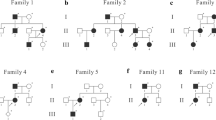Abstract.
Three members of a Portuguese family, who exhibited clinical evidence of neurofibromatosis type 1 (NF1), were found to possess different heritable and pathological mutations in their NF1 genes: a 1.5-Mb deletion spanning the entire NF1 gene, a truncating CGA→TGA transition in exon 22 (R1241X), and a frameshift mutation in exon 29 (5406insT). All three lesions occurred de novo and are likely to have been generated by different mutational mechanisms. At least two of the mutations occurred on different chromosomal backgrounds. The probability of finding three non-identical NF1 gene lesions arising de novo in a family with NF1 is very remote, too low to be readily accepted as mere coincidence. A number of possible explanations for this unique finding were therefore explored, but none were found to be wholly convincing. This report nevertheless serves as a reminder that it is unwise, even in the case of an autosomal dominant condition, to extrapolate from the detection of a single mutation in a specific individual to assuming an identical molecular genetic aetiology in other clinically affected members of the same family.
Similar content being viewed by others
Author information
Authors and Affiliations
Additional information
Electronic Publication
Rights and permissions
About this article
Cite this article
Upadhyaya, M., Majounie, E., Thompson, P. et al. Three different pathological lesions in the NF1 gene originating de novo in a family with neurofibromatosis type 1. Hum Genet 112, 12–17 (2003). https://doi.org/10.1007/s00439-002-0840-1
Received:
Accepted:
Issue Date:
DOI: https://doi.org/10.1007/s00439-002-0840-1




